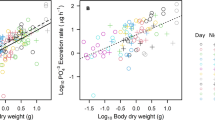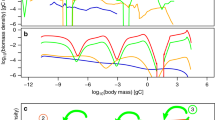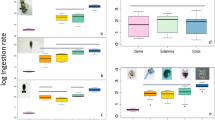Abstract
ACCORDING to the size–efficiency hypothesis1, body size is one of the most important determinants of the relative abundance of planktonic animals in nature. First, large-bodied species are more vulnerable to predation by visually feeding planktivorous fishes. Second, they are superior competitors for resources, being able to grow and reproduce at lower food concentrations. But whereas the first assumption has been confirmed by many field and experimental data (for review see refs 2–4), the second suggestion lacks experimental evidence and has been frequently questioned5-12. I now present experimental data from eight filter-feeding species (family Daphnidae) that strongly support the cornerstone assumption of the competitive aspect of the size-efficiency hypothesis. These data show that the threshold food concentration necessary to assure that assimilation equals respiration13, is lower for the large-bodied species than it is for the small-bodied species under steady-state and low-mortality conditions.
This is a preview of subscription content, access via your institution
Access options
Subscribe to this journal
Receive 51 print issues and online access
$199.00 per year
only $3.90 per issue
Buy this article
- Purchase on Springer Link
- Instant access to full article PDF
Prices may be subject to local taxes which are calculated during checkout
Similar content being viewed by others
References
Brooks, J. L. & Dodson, S. I. Science 150, 28–35 (1965).
Gliwicz, M. Z. & Pijanowska, J. Plankton Ecology: Succession in Plankton Communities (ed. Sommer, U.) (Springer, Berlin, 1989).
Kerfoot, W. C. (ed.) Predation: Direct and Indirect Impacts on Aquatic Communities (New England University Press, Hanover, New Hampshire, 1987).
Zaret, T. M. Predation and Freshwater Communities (Yale University Press, 1980).
Dodson, S. I. Ecology 55, 605–613 (1974).
Hanski, I. & Ranta, E. J. Anim. Ecol. 52, 263–279 (1983).
Lynch, M. Ecology 58, 763–774 (1977).
Lynch, M. Limnol. Oceanogr. 24, 253–272 (1979).
Lynch, M. in Evolution and Ecology of Zooplankton Communities (ed. Kerfoot, W. C.) (New England University Press, 19803).
Romanovsky, Y. E. Int. Rev. ges. Hydrobiol. 69, 613–632 (1984).
Romanovsky, Y. E. Arch. Hydrobiol. 21, 363–372 (1985).
Tillmann, U. & Lampert, W. J. Fresh. Ecol. 2, 311–323 (1984).
Lampert, W. Arch. Hydrobiol. (Suppl.) 48, 361–368 (1977).
Rothhaupt, K. O. Arch. Hydrobiol. (in the press).
DeMott, W. R. Oecologia 68, 334–340 (1986).
Lampert, W. in Daphnia (eds Peters, R. H. & deBernardi, R.) 143–192 (Mem. 1st. Ital. Idrobiol. Vol 45, 1987).
Geller, W. & Muller, H. Oecologia 49, 316–321 (1981).
Draper, N. R. & Smith, H. Applied Regression Analysis (Wiley, New York, 1981).
Hall, D. J., Threlkeld, S. T., Burns, C. W. & Crowley, P. H. A. Rev. Ecol. Syst 7, 177–208 (1976).
Tessier, A. J. & Goulden, C. E. Limnol. Oceanogr. 32, 680–686 (1987).
Stich, H. B. & Lampert, W. Oecologia 61, 192–196 (1984).
Gliwicz, Z. M. Ekol. pol. 25, 179–225 (1977).
Gliwicz, Z. M. & Lampert, W. Ecology (in the press).
Krambeck, H. J., Lampert, W. & Brede, H. Glas Instrument Technik Fachz. Lab. 25, 1009–1012 (1981).
Author information
Authors and Affiliations
Rights and permissions
About this article
Cite this article
Gliwicz, Z. Food thresholds and body size in cladocerans. Nature 343, 638–640 (1990). https://doi.org/10.1038/343638a0
Received:
Accepted:
Issue Date:
DOI: https://doi.org/10.1038/343638a0
This article is cited by
-
Daphnia magna (Crustacea: Anomopoda) in central Mexico wetlands: implications of escape from ecotoxicological laboratories
Biological Invasions (2024)
-
Long-term changes in morphological traits of Daphnia pulex in Lake Fukami-ike, Japan
Limnology (2021)
-
Grazing resistance in phytoplankton
Hydrobiologia (2021)
-
Resource competition among the Anostraca Dendrocephalus brasiliensis and three Neotropical cladocerans: implications on population dynamics and secondary production
Hydrobiologia (2020)
-
Underestimated species diversity and hidden habitat preference in Moina (Crustacea, Cladocera) revealed by integrative taxonomy
Hydrobiologia (2020)
Comments
By submitting a comment you agree to abide by our Terms and Community Guidelines. If you find something abusive or that does not comply with our terms or guidelines please flag it as inappropriate.



